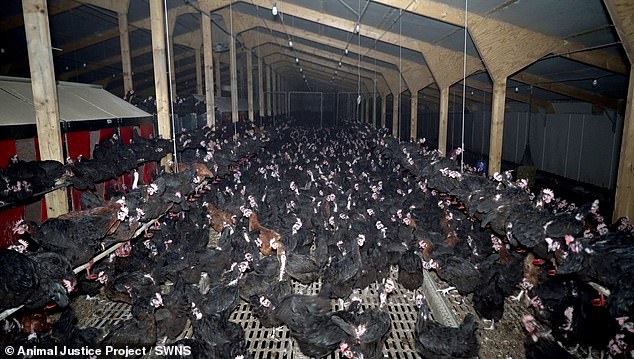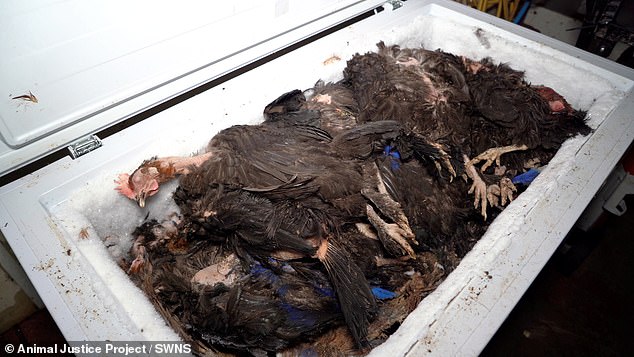Revealed: Up to one in fifteen fresh supermarket chickens is ‘highly infected’ with a deadly food poisoning bug… so is YOUR store the worst offender?
Data shows tens of thousands of fresh supermarket chickens harbored a potentially fatal food poisoning bug last year.
Waitrose was the worst offender, with as many as one in fifteen raw whole chickens carrying excessive levels of campylobacter. This exceeded strict safety limits.
The retailer blamed factors “beyond its control,” arguing that “unusually humid or foggy conditions” fueled the “unusually high” test results.
Campylobacter is the most common source of food poisoning. It typically causes diarrhea, nausea, and vomiting, which gets better naturally within a week.
However, in severe cases it can be life-threatening for vulnerable groups, including young children, the elderly and people with suppressed immune systems.
It comes as five farms were stripped of their ‘RSPCA Assured’ status last month after an undercover investigation revealed chickens were living in ‘appalling’ conditions. Pictured is overcrowding at Harper Farm, where researchers witnessed cannibalism, neglect and bullying
Supermarkets must report figures on the prevalence of campylobacter in their poultry products every three months so that Food Standards Agency (FSA) officials can monitor food quality.
They share the portion of their raw chicken that contains more than 1,000 colony-forming units per gram (CFU/g) of campylobacter.
At this level, chickens are considered contaminated and are at a higher risk of food poisoning.
Retailers must also ensure that no more than seven percent of their chickens exceed this level.
Data for 2023 obtained by MailOnline shows that 7.1 per cent of all Waitrose samples recorded between October and December contained more than 1,000 colony-forming units per gram (CFU/g).
For comparison: the supermarket recorded 4.04 percent between January and March and 2 percent between April and September.
In 2022, only 1.28 percent of all Waitrose raw chickens tested contained more than 1,000 cfu/g.
While the chain acknowledged that the figures were “unusually high,” it argued that “campylobacter levels may be adversely affected by seasonal changes and local weather conditions.”
A spokesperson told MailOnline: ‘We are confident that these isolated results, based on a very small sample size, do not reflect a trend working towards understanding this anomaly.’
Lidl, meanwhile, recorded the second highest rate overall in 2023, with an average of 3.5 percent over the four quarters.
Morrisons, Marks and Spencer and Co-op all saw average rates of less than two percent in the periods for which they shared data.
Tesco and Sainsbury’s have both stopped publishing data as they changed the way they monitor the pathogen in chicken. Their findings are therefore not comparable with those of other retailers.
Aldi has not yet updated its web page or provided the figures to MailOnline.
A spokesperson for Sainsbury’s told MailOnline: ‘The safety of our products is extremely important to us and we have implemented a range of processes to monitor and limit the levels of campylobacter in our fresh chicken.
‘We have consistently achieved the FSA target for campylobacter levels for several years and therefore we will no longer formally report on this.’
It comes as five farms were stripped of their ‘RSPCA Assured’ status last month after an undercover investigation revealed chickens were living in ‘appalling’ conditions.
The free-range egg farms in Leeds, Powys and Leicestershire all supplied major supermarkets in the UK, including Sainsbury’s.
Secretly filmed footage from Animal Justice Project (AJP) showed the tens of thousands of birds living in dark and cramped sheds surrounded by the bodies and skeletons of dead chickens.
In some cases, the horrific conditions caused the chickens to become distressed, causing them to lose feathers and exhibit behaviors towards each other, including bullying, aggressive pecking and even cannibalism.

The free-range egg farms in Leeds, Powys and Leicestershire all supplied major supermarkets in the UK, including Sainsbury’s. Chickens are pictured huddled in one of the sheds on the farm in Powys

In some cases, the horrific conditions caused the chickens to become distressed, causing them to lose feathers and exhibit behaviors towards each other, including bullying, aggressive pecking and even cannibalism. Pictured is a freezer full of dead chicken carcasses on the farm in Powys
Campylobacter is responsible for an estimated 50,000 cases of illness in England each year and is one of the top four causes of diarrhea in the world.
More worrying is the fact that some strains of bacteria have mutated and developed resistance to antibiotics used by doctors to treat serious diseases.
The latest statistics show that the average Briton consumes 35kg of poultry meat every year.
Apart from the misery and pain of the disease itself, the FSA estimates that the bacteria costs the economy around £900 million a year in terms of NHS treatment and days lost at work.
To avoid food poisoning, people should make sure they cook chicken thoroughly, separate meat from other foods, keep it in the refrigerator and wash their hands and utensils after handling raw meat, the FSA said.
Chicken should also not be washed as this could cause bacteria to splash elsewhere in the kitchen, it added.
